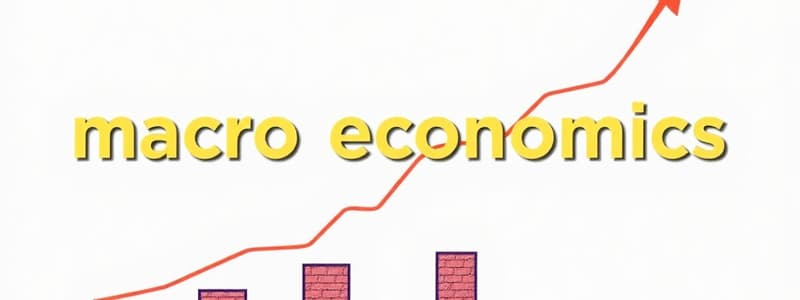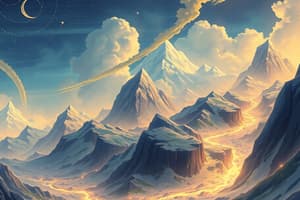Podcast
Questions and Answers
Capital from foreign countries may flow into the domestic country, or the domestic country may be exporting capital to ______.
Capital from foreign countries may flow into the domestic country, or the domestic country may be exporting capital to ______.
foreign countries
Macroeconomics deals with the aggregate economic variables of an ______.
Macroeconomics deals with the aggregate economic variables of an ______.
economy
Macroeconomics emerged as a separate subject in the ______ due to Keynes.
Macroeconomics emerged as a separate subject in the ______ due to Keynes.
1930s
Macroeconomics sees an economy as a combination of four sectors, namely households, firms, ______, and external sector.
Macroeconomics sees an economy as a combination of four sectors, namely households, firms, ______, and external sector.
The Great Depression had provided Keynes with the inspiration for his ______.
The Great Depression had provided Keynes with the inspiration for his ______.
The subject of ______ was born.
The subject of ______ was born.
Production activities in a capitalist country are mainly carried out by ______ enterprises.
Production activities in a capitalist country are mainly carried out by ______ enterprises.
A typical capitalist enterprise has entrepreneurs who exercise control over major ______ and bear risks.
A typical capitalist enterprise has entrepreneurs who exercise control over major ______ and bear risks.
To carry out production, enterprises need natural resources, which can be raw materials and fixed ______.
To carry out production, enterprises need natural resources, which can be raw materials and fixed ______.
The three factors of production are capital, land, and ______.
The three factors of production are capital, land, and ______.
The money earned from selling products is called ______.
The money earned from selling products is called ______.
Part of the revenue is paid as interest to ______ for their services.
Part of the revenue is paid as interest to ______ for their services.
Profits are often reinvested in the business to buy new machinery or build new ______.
Profits are often reinvested in the business to buy new machinery or build new ______.
Macroeconomics differs from ______ because it deals with the economy as a whole.
Macroeconomics differs from ______ because it deals with the economy as a whole.
Questions about the overall rise or fall of ______ are central to macroeconomic studies.
Questions about the overall rise or fall of ______ are central to macroeconomic studies.
The employment condition of the country is a fundamental aspect of ______.
The employment condition of the country is a fundamental aspect of ______.
Indicators that show whether the economy is better or worse are studied in ______.
Indicators that show whether the economy is better or worse are studied in ______.
In macroeconomics, the output levels of all goods and services tend to move ______.
In macroeconomics, the output levels of all goods and services tend to move ______.
The output of food grains and industrial goods generally ______ each other.
The output of food grains and industrial goods generally ______ each other.
An increase in the output level of one good can lead to a rise in ______ of others.
An increase in the output level of one good can lead to a rise in ______ of others.
Analyzing the entire economy becomes relatively ______ when aggregate levels are related.
Analyzing the entire economy becomes relatively ______ when aggregate levels are related.
The ______ is a key concept that indicates the cost of borrowing money.
The ______ is a key concept that indicates the cost of borrowing money.
In a capitalist economy, firms operate to maximize their ______.
In a capitalist economy, firms operate to maximize their ______.
The ______ refers to the global economic crisis that began in 1929.
The ______ refers to the global economic crisis that began in 1929.
The four factors of production include land, labor, capital, and ______.
The four factors of production include land, labor, capital, and ______.
Inputs such as labor and capital are utilized to create ______.
Inputs such as labor and capital are utilized to create ______.
In macroeconomics, the ______ sector includes households, firms, the government, and the external sector.
In macroeconomics, the ______ sector includes households, firms, the government, and the external sector.
We can think of a single good as the representative of all the goods and services produced within the ______.
We can think of a single good as the representative of all the goods and services produced within the ______.
The price or employment level of this representative good will reflect the general price and employment level of the ______.
The price or employment level of this representative good will reflect the general price and employment level of the ______.
______ refers to the additional investments made to increase capital stock.
______ refers to the additional investments made to increase capital stock.
The unemployment rate measures the percentage of the labor force that is ______.
The unemployment rate measures the percentage of the labor force that is ______.
In macroeconomics, we focus on a single imaginary ______ to simplify analysis.
In macroeconomics, we focus on a single imaginary ______ to simplify analysis.
What happens to the prices, interests, wages and profits for one commodity usually also happens for the ______ as a whole.
What happens to the prices, interests, wages and profits for one commodity usually also happens for the ______ as a whole.
Inflation occurs when prices are going ______.
Inflation occurs when prices are going ______.
When employment and production levels are going down, the economy is ______ for a depression.
When employment and production levels are going down, the economy is ______ for a depression.
The general directions of the movements of these variables for all individual commodities are usually of the same kind as are seen for the ______.
The general directions of the movements of these variables for all individual commodities are usually of the same kind as are seen for the ______.
Sometimes, we also depart from this useful simplification when we realize that the country's economy may be composed of distinct ______.
Sometimes, we also depart from this useful simplification when we realize that the country's economy may be composed of distinct ______.
Adam Smith is regarded as the founding father of modern ______.
Adam Smith is regarded as the founding father of modern ______.
Smith was a professor at the University of ______.
Smith was a professor at the University of ______.
His well-known work is titled 'An Enquiry into the Nature and Cause of the Wealth of ______.'
His well-known work is titled 'An Enquiry into the Nature and Cause of the Wealth of ______.'
Smith argued that we expect our dinner not from the benevolence of the ______, but from their regard to their own interest.
Smith argued that we expect our dinner not from the benevolence of the ______, but from their regard to their own interest.
The ______ of France were prominent thinkers of political economy before Smith.
The ______ of France were prominent thinkers of political economy before Smith.
Macroeconomists study the effects of taxation and other budgetary ______.
Macroeconomists study the effects of taxation and other budgetary ______.
Macroeconomics involves examining changes in money supply, the rate of interest, wages, employment, and ______.
Macroeconomics involves examining changes in money supply, the rate of interest, wages, employment, and ______.
Society decided to pursue certain important social goals ______.
Society decided to pursue certain important social goals ______.
Flashcards
Macroeconomics
Macroeconomics
The study of how the economy works as a whole, focusing on factors like overall production, employment, and price levels.
Microeconomics
Microeconomics
The study of individual economic decisions, like how a consumer chooses what to buy or how a firm sets its prices.
Inflation
Inflation
A general upward trend in prices across the economy.
Deflation
Deflation
Signup and view all the flashcards
Output
Output
Signup and view all the flashcards
Employment
Employment
Signup and view all the flashcards
Economic Health
Economic Health
Signup and view all the flashcards
Economic Policy
Economic Policy
Signup and view all the flashcards
Representative Good
Representative Good
Signup and view all the flashcards
Depression
Depression
Signup and view all the flashcards
Representative Good Assumption
Representative Good Assumption
Signup and view all the flashcards
Simplification in Macroeconomics
Simplification in Macroeconomics
Signup and view all the flashcards
Economic Sectors
Economic Sectors
Signup and view all the flashcards
General Direction of Movement
General Direction of Movement
Signup and view all the flashcards
What is macroeconomics?
What is macroeconomics?
Signup and view all the flashcards
What does capital inflow mean?
What does capital inflow mean?
Signup and view all the flashcards
What does capital outflow mean?
What does capital outflow mean?
Signup and view all the flashcards
What is microeconomics?
What is microeconomics?
Signup and view all the flashcards
What is a capitalist economy?
What is a capitalist economy?
Signup and view all the flashcards
Invisible Hand
Invisible Hand
Signup and view all the flashcards
Monetary Policy
Monetary Policy
Signup and view all the flashcards
Fiscal Policy
Fiscal Policy
Signup and view all the flashcards
Free Market Economy
Free Market Economy
Signup and view all the flashcards
Interventionist Economy
Interventionist Economy
Signup and view all the flashcards
Physiocrats
Physiocrats
Signup and view all the flashcards
Capitalist System
Capitalist System
Signup and view all the flashcards
Entrepreneur
Entrepreneur
Signup and view all the flashcards
Factors of Production
Factors of Production
Signup and view all the flashcards
Revenue
Revenue
Signup and view all the flashcards
Rent
Rent
Signup and view all the flashcards
Interest
Interest
Signup and view all the flashcards
Profit
Profit
Signup and view all the flashcards
Investment Expenditures
Investment Expenditures
Signup and view all the flashcards
Wage labor
Wage labor
Signup and view all the flashcards
Capitalist country
Capitalist country
Signup and view all the flashcards
Firms
Firms
Signup and view all the flashcards
Wage rate
Wage rate
Signup and view all the flashcards
Unemployment rate
Unemployment rate
Signup and view all the flashcards
Study Notes
Introduction to Macroeconomics
- Macroeconomics studies the economy as a whole, focusing on broad economic questions like price levels, employment, and overall economic health.
- It differs from microeconomics, which examines individual markets and agents.
- Macroeconomic questions include: overall price trends, employment conditions, and ways to improve the economy overall.
- Macroeconomics analyses the aggregate output, price, and employment levels of an economy. These variables often move together.
- Output levels (food, industrial goods, services) tend to rise or fall simultaneously.
- Prices of different goods and services usually move together.
- Employment levels in different sectors often change in tandem.
Economic Agents
- Economic agents are individuals or institutions involved in economic decision-making.
- Examples include consumers, producers (firms), governments, and corporations.
- Each agent makes decisions about consumption, production, spending etc.
Macroeconomics vs. Microeconomics
- Microeconomics studies individual markets (supply and demand), individual agents (consumers, and producers) and their decisions/interactions.
- Macroeconomics focuses on the economy as a whole, examining broad aggregates such as overall output, prices, employment etc.
Macroeconomic Players
- The key players in a capitalist economy are firms, households, and the government.
- Firms produce and sell goods and services.
- Households consume and save.
- The government collects taxes, provides public services, and regulates the economy.
Context of Macroeconomics
- Macroeconomics is influenced by historical factors, particularly in contexts like capitalist economies.
- The economy of a capitalist country is characterized by private firms, wage labor, and profit-oriented decisions.
Studying That Suits You
Use AI to generate personalized quizzes and flashcards to suit your learning preferences.




